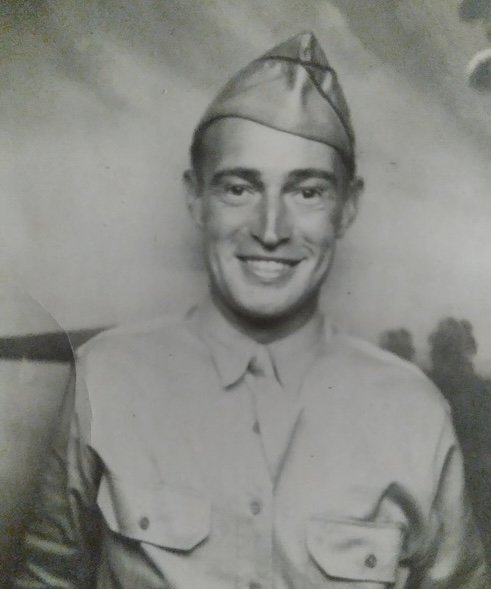Raymond Carey
ASN: O-1176572
LT Raymond Carey
Raymond Thomas Carey, Jr., registered for the draft on October 16, 1940. Born March 20, 1917 he was from Schuylerville, New York. His place of employment was Iroquois Paper Company, Thomson, New York. This twenty-three-year-old was 5-10, 145 pounds with a light complexion, brown eyes and brown hair.
It is believed he enlisted in the Army in 1941. Later promoted to a 2nd Lieutenant, Carey received his training at Fort Bragg, North Carolina and assigned to A-Battery. He is pictured (inset) on September 26, 1942, the 319th was now a glider field artillery battalion of the 82nd Airborne Division.
Along with fellow Glider men and officers, LT Carey sailed to North Africa in May, 1943. He fought with the 319th in Maiori, Italy and at the Volturno River. LT Carey later sailed on the U.S.S. Joseph T. Dickman with the 319th to northern Ireland arriving December 9, 1943.
While stationed in Ireland LT Carey was relieved from his assignment and duties of A- Battery and transferred to the HQ-Battery of the 319th on December 20, 1943.
February 23, 1944, LT Carey was reassigned to the HQ-Battery Principle duty Battery Officer. He later traveled with the battalion to their new base camp in Market Harborough, England, training for the upcoming Normandy invasion.
May 1944 - Papillon Hall - Market Harborough, England (L-R), Sebert Meadows, Forest McLain, Alva Cole, Raymond Carey (kneeling), Henry Rajhert, (standing), soldier (seated) unknown
2nd LT Carey, Youngstown, Ohio - March 1943
Company Morning Reports
Morning Reports were produced every morning to record personnel matters (see below). As indicated LT Carey was on leave for 5 days from the 2nd of March until the 6th of March 1944. On April 10, 1944, LT Carey was reassigned to A-Battery. He glided into Normandy the evening of June 6, 1944 with the 319th, codenamed Mission Elmira.
2nd LT Raymond Carey
On July 4, 1944, 2nd LT Carey was killed in action. The battalion supported an attack on Hill 95 by the 508th Parachute Infantry Regiment at 0900 hours, near LaCotellerie-Picauville, France, and was met with a terrific pushback of artillery, machine gun, and mortar fire.
The assault had only just been launched when a mortar round landed square among the liaison team from A-Battery, wiping them out. LT Carey, acting as Liaison Officer/forward observer with the 508th PIR and after relieving LT Ragland from his forward observer position, was killed along with fellow soldiers PVT Eugene Smith and PVT Theodore Ratlief.
Years later LT Ragland was still troubled by Carey’s death, having only traded places with him a few hours before. “I told my wife once, I think LT Carey must have taken my place,” Ragland said regretfully. “He wasn’t there but half a day and he got killed. You just don’t know.”
LT Carey’s death was a profound loss to his family in Schuylerville, New York. His grieving mother, a devout Catholic, had such faith she believed he would one day walk through the front door. His bedroom would be kept like a museum displaying the American flag and memories of high school and Fordham University. July 4th would forever be a solemn day in the Carey household.
A New York news paper article recognized 2nd LT Carey’s death according to the War Department, citing his participation in the invasions of Sicily and Salerno before being transferred to England with the airborne artillery glider troops. At the time of his death he was survived by his parents and two brothers who were also serving in the military in New Guinea and England.
2nd LT Raymond T. Carey was awarded 3 Bronze Battle Stars, Bronze Arrowhead, Purple Heart, Good Conduct Medal, Presidential Unit Citation Badge, Victory Ribbon and the European-African-Middle Eastern Theatre Ribbon.
He was buried with honors at the Normandy American Cemetery, Plot F Row 14 Grave 44, Colleville-sur-Mer, France.
God bless this hero.














